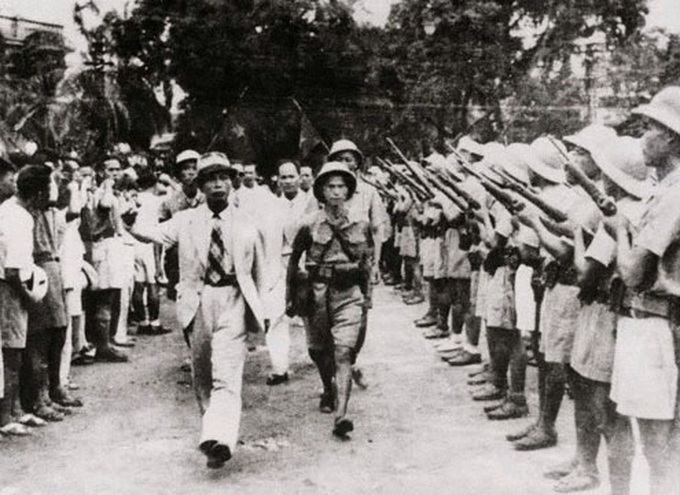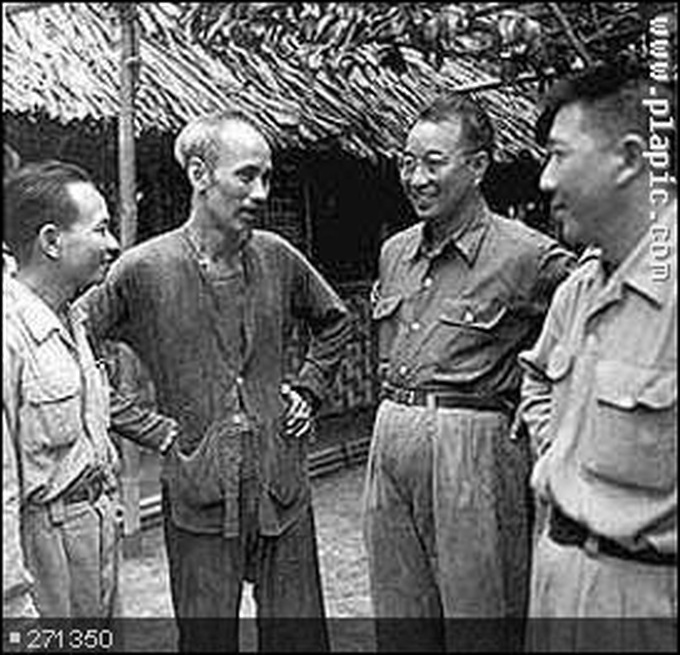Ho Chi Minh had been patient, diplomatic, persistent but polite. Now the time had come to take off the velvet glove and reveal the iron fist, writes Laura Lam in the 22nd part of her series.
Although the French didn’t officially declare war against Viet Nam until December 1946, in reality French troops had forced their way back into Sai Gon the year before. They had military assistance from the British. Leading his troops, General Jacques Leclerc announced his entry to Sai Gon on 24 September 1945, “We have come to reclaim our inheritance”. Upon hearing Leclerc’s statement, Vo Nguyen Giap wept.

Vo Nguyen Giap’s Liberation Army, August 1945
As he witnessed more human losses and suffering on both sides of the ongoing conflict, Ho Chi Minh tried to reconcile with the French. In January 1947, he wrote to Jean Sainteny, who was Charles de Gaulle’s emissary to Viet Nam.
“There are already enough deaths and enough ruins! What are we to do now, you and I? France has only to recognize the independence and unity of Viet Nam, and at once hostilities will cease. I am ready to work for peace, a just and honorable peace for our two countries. I hope that you, on your side, will be working to the same end.”
Jean Sainteny never answered Ho Chi Minh’s letter. Ho then sent a ceasefire proposal to the French High Commissioner for Indochina, Emile Bollaert. It was rejected. Charles de Gaulle had already instructed Bollaert not to give up any part of Viet Nam’s territory to the Viet Minh.
Ho Chi Minh tried to seek help from the US government but this effort failed too. The Americans would actively take sides with the French throughout the French War (1946-54), having recognized France’s claim to Indochina.
On Viet Nam’s side, under the direction of the Chinese Communist Party (CCP), an official military advisory body was formed in April 1950. This was to help with planning and training of the Viet Minh guerilla forces fighting against the French. Ho Chi Minh’s loyal friend, Chen Geng, known as the “Scholar General”, together with General Wei Guoqing, would lead the advisory group to North Viet Nam. The group consisted of men and women with commanding experiences from the Second Sino-Japanese War and the Chinese Civil War.
The Chinese Civil War ended in May 1950. The Korean Civil War broke out the following month. On June 25, while North Korean troops were crossing the 38th Parallel, Mao Zedong spoke to his military advisers en-route to Viet Nam, “Who would have thought our revolution would succeed first? We should help the Vietnamese. It is called internationalism. You will help them to win the battles after you get to Viet Nam.”
Logistical support from China began to increase steadily. A transportation network including roads and railways was rebuilt between China and Viet Nam. The military aid provided by China would enable the Vietnamese to expand their force, capable of defeating the French Army in large-scale offensive operations. By 1952, four more divisions were added to the three Viet Minh divisions. The upgraded army of seven divisions was well equipped with small arms, machine guns, heavy 120mm mortars and 105mm howitzers, in addition to 20 and 40mm anti-aircraft guns.
Earlier, the Vietnamese response against the French consisted of a low-level rural insurgency. When Franco-British troops took over Sai Gon in September 1945, the United States began sending senior military advisers and massive military aid to the French. The conflict soon turned into a major war between two armies equipped with modern weapons, especially on the French side. Even though President Roosevelt had despised the abuses of French colonial rule, US policy was shaped mainly by a concern about serious breakdown of the French state in Europe at that time. China and the Soviet Union supported the liberation of France’s colonies.

From left to right: Vo Nguyen Giap, Ho Chi Minh, Chen Geng (Trần Canh), and a member of Chinese advisory group
The year 1949 marked a turning point for the Vietnamese and their war of liberation. Vo Nguyen Giap and Chen Geng had effectively re-organized the Viet Minh’s local irregular forces into five full conventional infantry divisions – the 304th, 308th, 312th, 316th and the 320th. The war began to intensify when the Viet Minh went on the offensive, attacking isolated French bases along the Sino-Vietnamese border. The French, with 10,000 troops near the border, lost 6,000 in battles. A large number of French weapons and supplies were damaged or destroyed. Being outnumbered by the Viet Minh Army, 8 to 1, the French Army would lose control of most of the border region by the year-end.
To commemorate the border victories, Ho Chi Minh composed two Chinese poems and dedicated them to Chen Geng. In response, Chen said to Ho, “Your steely determination will ensure great victory! I am confident of a French defeat. There will be little chance of surviving for them.”
When Ho Chi Minh sought the assistance of the CCP, he privately shared with Chen Geng and Zhu De his country’s dilemma. The Viet Minh army was suffering from severe financial handicap and was also constantly persecuted by the French. It was poorly equipped compared to the enemy and lacked training for combat.
Chen Geng wrote a report following the first series of attacks, acknowledging that the Vietnamese crack units were in a state of high morale after receiving their training and equipment in Yunnan and Guangxi. However, Vietnamese senior cadres above the battalion level lacked command experience in actual combat. Chen assured Ho that he and General Wei Guoqing (Vi Quốc Thanh) would provide the Viet Minh with intensive training before the Border Campaign, which would begin in September 1950.
The Korean Civil War was escalated. Mao Zedong appointed Chen Geng to be Deputy-Commander-in-chief of the Chinese forces supporting North Korea. Chen Geng bade farewell to Ho Chi Minh and the Viet Minh troops in November 1950, taking on his new assignment. Mao and the government of North Korean wanted to launch a counter-offensive to repel the Americans and their allies’ forces past the 38th Parallel. While the United States provided support to South Korea, China and the Soviet Union aided North Korea.
Vo Nguyen Giap and the Chinese advisory group under General Wei Guoqing would gradually build a strong, well-equipped, experienced, and dedicated army. Their great task would be the climactic battle of Dien Bien Phu near Laos. The tide turned in the Viet Minh’s favor when a copy of the Navarre Plan was secretly revealed to them, outlining the goals and objectives of the new French Commander in Indochina, Henri Navarre.
With the signing of the Korean Armistice in July 1953, China shifted its military resources to Viet Nam. Specific support for the Dien Bien Phu campaign included careful planning, logistics, engineering advisors, trucks, rockets, 75mm recoilless rifle battalions, and the Soviet rocket launchers known as “Stalin Organs.” The Viet Minh set up their headquarters at Dien Bien Phu, with Vo Nguyen Giap as Commander-in-Chief and Wei Guoqing as Advisory General.
The coordination efforts between the Viet Minh and the Chinese advisory team went smoothly and they felt confident that they would win the great battle. The Chinese advisory group would be involved at all levels during combat. China's generous support helped boost the morale and fighting capabilities of the Viet Minh and offset the Navarre Plan. Navarre himself had stated in mid-1953 that his plan was viable if the flow of supplies entering Viet Nam from China did not increase significantly.
The battle of Dien Bien Phu is now seen as a turning point in world history. For hundreds of years the powers of Europe had expanded their reach outside their natural territory and had taken over large parts of the rest of the world. This explosive force was based on their increasing prosperity, in turn based on their advanced science and technology, and on a long series of their own political revolutions. World War II weakened this structure. In effect, Dien Bien Phu brought it to an end. That battle led not just to a new definition of relations between Viet Nam and France, but to a new definition of relations between the rich nations and all those intending to become rich on their own terms, and in their own time.
(a parallel series of articles on “The Battle of Dien Bien Phu” by Laura Lam examines its drama. DTiNews will soon introduce it to readers).
